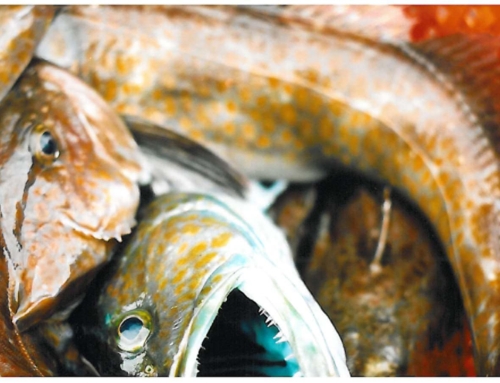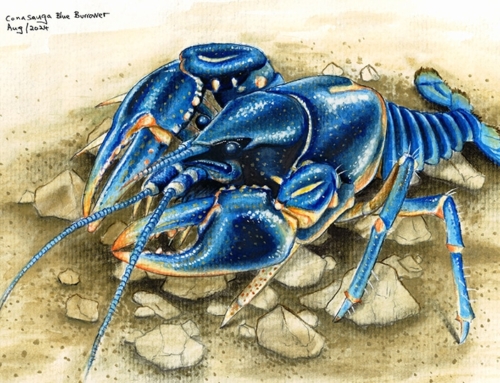We are delighted to report that our Director of Strategic Conservation, Dr Simon Stuart, has been awarded the 2020 Blue Planet Prize, the esteemed international environmental award sponsored by the Asahi Glass Foundation.
Every year, the Foundation selects two winners, individuals or organisations who have made significant contributions to the resolution of global environmental problems. Simon has received the award alongside Professor David Tilman, an ecologist whose research on health and environmental impacts of dietary choices has brought the relationships between our food, our health and our environment to light.
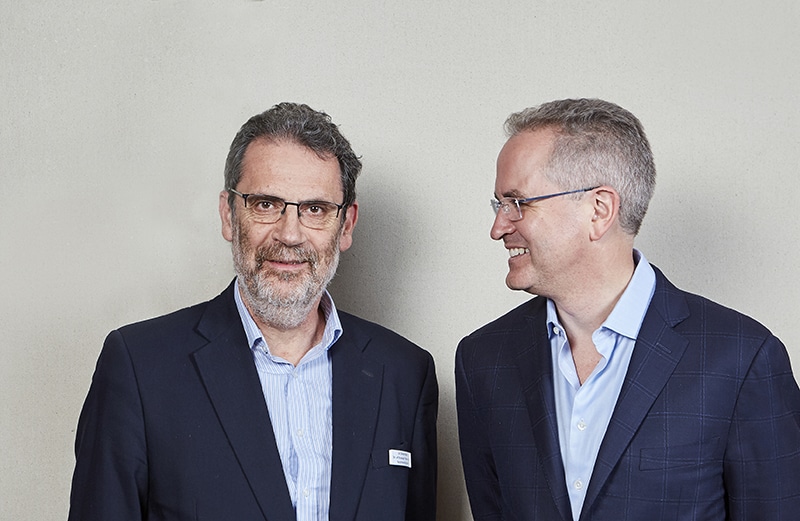
Dr Simon Stuart (left) and his friend and colleague Jonathan Baillie. Image: James Wicks
Understanding extinction
Much of Simon’s career – about 40 years – has been spent working at the International Union for Conservation of Nature (IUCN). For the last eight of these, he chaired the Species Survival Commission, guiding the development of the IUCN Red List of Threatened Species, a database which currently holds conservation data on more than 110,000 species. The work Simon led, together with Prof Georgina Mace, on developing new quantitative criteria and categories for the Red List have led to it becoming the go-to source of information on species extinction risk. It is widely used by conservationists, decision-makers (in both governments and the private sector), scientists and educators around the world.
“When Georgina and I embarked on the process to develop the new IUCN Categories and Criteria, we had no idea what we were getting into,” says Simon. “Our aim was to bring rigour and consistency into the process of assessing the extinction risk of species. We ended up achieving this, and it became so much more.”
As IUCN’s Senior Species Scientist in the early 2000s, he founded a new Biodiversity Assessment Unit, which undertook crucial assessments of the world’s mammals, birds, reptiles, marine species and amphibians. These assessments provided a vital foundation to better understand the extinction crisis, but the number of species classified as globally threatened with extinction was a wake-up call:
- 32% of amphibians (1,991 species)
- 22% of marine species (560 species)
- 21% of mammals (1,141 species)
- 19% of reptiles (1,726 species)
- 12% of birds (1,227 species)
Simon says that he had not anticipated the impact of the rigorous new criteria and the resulting assessments. “We didn’t expect the IUCN Red List to become one of the key datasets to guide funding decisions by numerous donors, including huge ones like the Global Environment Facility; we didn’t expect it to become a key component in the tool to guide how governments and corporations can minimise their impacts on threatened species; we didn’t even expect it to produce over 100,000 maps of species’ distributions, thus making spatial conservation planning so much more practical; nor did it occur to us that it would become the basis of other data standards such as Key Biodiversity Areas.”
A better understanding of extinction risk can catalyse efforts to reverse the downward trend and to monitor the effectiveness of conservation; in 2010 a study using IUCN Red List data was the first to present clear evidence of the positive impact of conservation efforts around the world, showing that the status of biodiversity would have declined by nearly 20 per cent if conservation action had not been taken. A follow-up study in 2015 using the world’s 235 hooved mammal species as a sample showed that without conservation action, the overall increase in species’ extinction risk would have been nearly 8 times worse than it had been.
“Conservation works, there’s just not enough of it.”
Simon Stuart, What is Conservation?
What should we conserve?
As Chair of the IUCN Species Survival Commission, Simon’s role was to head the 10,000-member Commission on species conservation issues worldwide – using the huge research banks to lead the global coordination of species conservation.
From 2012 to 2016, Simon facilitated the creation of a global standard to identify the precise places that are the ‘crown jewels’ for biodiversity conservation, working with Penny Langhammer, among others, to identify and classify these as Key Biodiversity Areas. Key Biodiversity Areas are ‘sites contributing significantly to the global persistence of biodiversity’ in terrestrial, freshwater and marine ecosystems. They are classified under a rigorous scientific standard and provide a vital tool for communities, conservation organisations and governments to prioritise habitats for protection.
Simon says “Aldo Leopold famously wrote: ‘To keep every cog and wheel is the first precaution of intelligent tinkering.’ If we are not to lose the cogs and wheels (the genes, species and ecosystems) of nature, then we must do conservation in the right places.
This is what Key Biodiversity Areas are. They are defined through science, but their exact boundaries are drawn through a bottom-up process with local communities.”
By identifying priority habitats and analysing species assessments, the work Simon led at the IUCN shone a light on conservation priorities such as freshwater species and ecosystems, and regions in urgent need of increased conservation action which had so far slipped under the radar. For example, the mammal assessment brought the plight of species in South-east Asia to global attention. South-east Asia has a high proportion of unique species which cannot be found anywhere else, but its biodiversity faces greater threat of extinction under the pressures of habitat loss and wildlife trade. One study estimated that South-east Asia could lose 42% of its biodiversity by 2100. In response, Simon and his team founded the Asian Species Action Partnership (ASAP). ASAP is an alliance which draws on the collective expertise of conservation individuals and organisations to pool resources and efforts aimed at reversing the declines in Asia’s unique species.
“When we looked at the results of IUCN’s mammal assessment, we were shocked to see how the levels of threat were especially serious in Southeast Asia,” says Simon. “A combination of very high human pressure (often related to break-neck economic growth), weak conservation capacity, and low levels of political commitment to environmental issues has created a crisis which could see the loss of many species. However, it is heartening to see the growing enthusiasm that ASAP has created, leading to a new resolve to safeguard the extraordinary natural heritage of this remarkable region.”
The role of zoos

A Sunda wrinkled hornbill, a south-east Asian species classified as Endangered by the IUCN Red List, photographed in Chester Zoo. Image: Steve Wilson
Bringing together expert individuals and organisations to tackle urgent conservation problems has been a repeating theme in Simon’s career. One group of organisations which Simon worked hard to bring into the global conservation community was zoos, who responded particularly to the plight of Asian species. Zoos have become not only one of the greatest centres for educating the public about conservation, but they also provide incredibly important funding to the frontlines of conservation. It is estimated that collectively, members of the World Association of Zoos and Aquariums contribute more than $350 million annually to species conservation.
“The contribution that the world’s zoos make to conservation is now enormous – this is an huge positive change compared with when I started out 40 years ago,” says Simon. “When we put out the call to action over Southeast Asian species, the European Association of Zoos and Aquariums launched a year-long campaign in their many zoos – this resulted in much greater awareness of, and significant new funding for, these species.
“Zoos have also been the main group of organisations and funders that have responded to the amphibian crisis. Much of my career has been devoted to helping to bring the zoo community fully into conservation. Now as I look back and see how enormously the contributions of zoos has grown, I feel tremendous satisfaction.
“However, all of this is now in jeopardy because of the effects of the COVID-19 pandemic. I know of many organisations and conservation projects in tropical countries that are dependent on zoo funding and which are now in great difficulty. Here in the UK, our zoos give a minimum of £31 million to conservation annually. I am relieved that the government has at last agreed that zoos can reopen. However, there is an urgent need for the government to provide our zoos with the necessary bridge funding to keep all of their operations and vital conservation programmes around the world going. We need action on this now!”
Amphibians: a neglected crisis
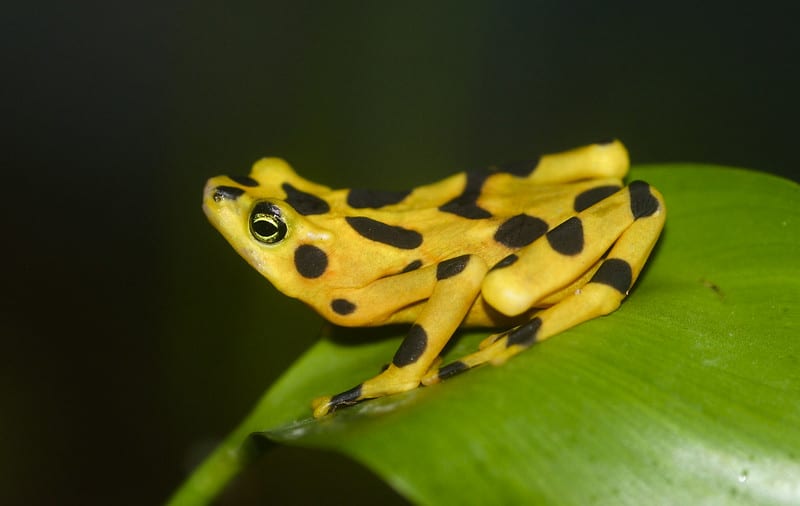
The Panamanian Golden Frog is a Critically Endangered species which began vanishing from its habitat in the late 1990s due to the fungal disease chytridiomycosis. Image: Brian Gratwicke
In 2004 the first Global Amphibian Assessment, which Simon led, confirmed what herpetologists had feared since the first World Congress of Herpetology in 1989 – that amphibian populations were disappearing at an unprecedented rate from around the world. The shocking statistics gathered by the IUCN catalysed the founding of the Amphibian Survival Alliance. Simon was one of the conservationists calling for drastic action for amphibians and has supported the growth of the Amphibian Survival Alliance through his work at the IUCN and at Synchronicity Earth.
At Synchronicity Earth, Simon has led the Amphibian programme, which provides core support for the Amphibian Survival Alliance as part of its three-fold mission to improve the knowledge base to guide amphibian conservation; build capacity and support development of amphibian conservation organisations; and fund and support increased amphibian conservation.
Before Simon became Director of Strategic Conservation, he was a close advisor to Synchronicity Earth, helping to align the focus of its programmes with priorities he had helped to identify through his work at the IUCN: amphibians, Asian species and freshwater. Since he became Director of Strategic Conservation, these programmes have developed with numerous new partners specialising in these areas receiving grants for their work, being supported by capacity-building programmes and knowledge-sharing between networks working on similar issues. These programmes complement our existing work focusing on the High and Deep Seas and Congo Basin, which he has helped to develop into highly successful programmes.
Inspiration
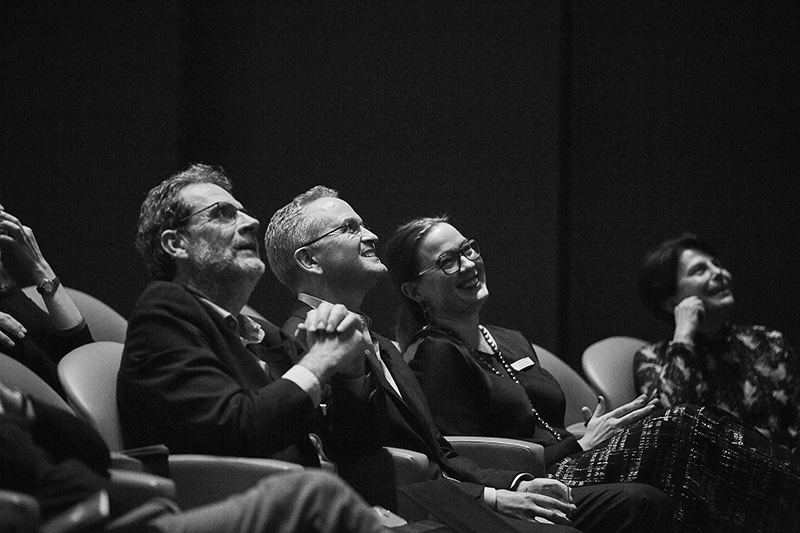
Simon (left) with Jonathan Baillie, Jessica Sweidan and Catherine Bryan. Image: James Wicks
Simon’s career as a conservationist began with a PhD studying forest bird communities in Tanzania, where his research ultimately contributed to the founding of Udzungwa National Park. As he said in an interview of his work in Tanzania, it was not his work “by any means myself alone, but I guess I was one of the pioneers in it, and others took up the flag after me.” Simon speaks of many pioneers who paved the way for his own achievements, and also conservationists whose passion gives him hope for the future.
“In receiving this prize, I realise that I owe everything to those who helped and encouraged me on my journey. First of course is my wonderfully supportive wife, Ann, and daughters Claire and Jyo, who have had to put up with decades of my being over-busy and distracted!
“My mentors who really guided the way for me include George Rabb, Georgina Mace, Russ Mittermeier, Luigi Boitani, Jane Goodall and Ashok Khosla. My first boss (at BirdLife in 1983-1985) was the inspirational Nigel Collar – he is still there doing his magnificent work nearly 40 years on. I must mention Peter Harris who helped me pull together my Christian faith, passion for conservation and dedication to science in the most extraordinary way. I’ve had wonderful peers, including Jon Hutton, Cyrie Sendashonga, Jon Paul Rodríguez, Sue Mainka, Tom Kabii, Bihini Won wa Musiti, Jean-Christophe Vié, Tim Sullivan, Amie Brautigam, Tony Whitten, Susan Tressler and Vivek Menon.
“And perhaps the most exciting thing is to see all the truly talented people now stepping up to leadership. I can’t name them all, but they include the entire wonderful team at Synchronicity Earth, but also Kira Mileham, Mike and Rachel Hoffmann, Penny Langhammer, Tom Brooks, Jonathan Baillie, Jennifer Luedtke, Jeremy Harris, Nerissa Chao, Helen Meredith, Ariadne Angulo and many, many others. I owe so much to Adam and Jessica Sweidan who offered me a home at Synchronicity Earth after my IUCN days were over – there can have been no better place to land! And very importantly, spare a thought for those who kindly organised me and cleared up the mess after me for many years, especially two long-suffering saints: Doreen Zivkovic and Vera Hugues Salas.”
Synchronicity Earth is incredibly proud of Simon’s many achievements in the field of conservation and congratulates him for being awarded the Blue Planet Prize. Synchronicity Earth’s CEO Kirsty Schneeberger says “For those of us who know Simon – and within the conservation sector that’s an awful lot of people – the award of this prize comes as no surprise. His dedication and what he has achieved is an inspiration to all of us here at Synchronicity Earth. Congratulations, Simon!”
Contact Synchronicity Earth for interview enquiries.



